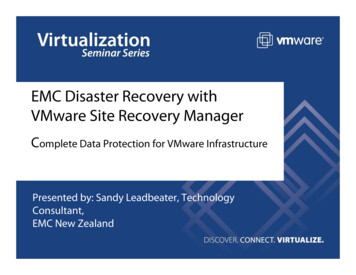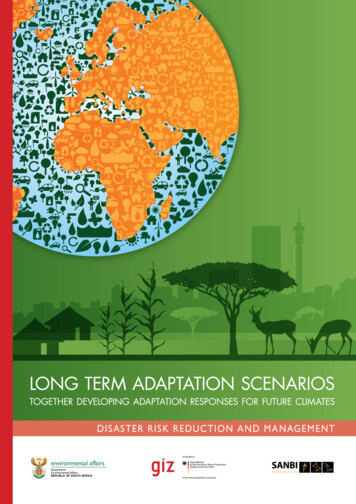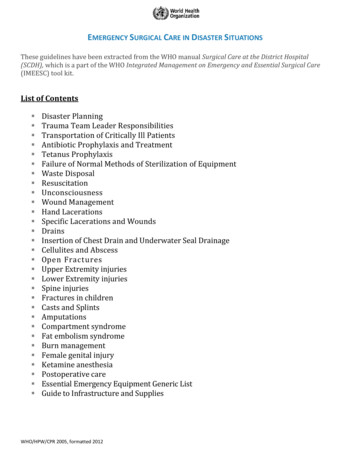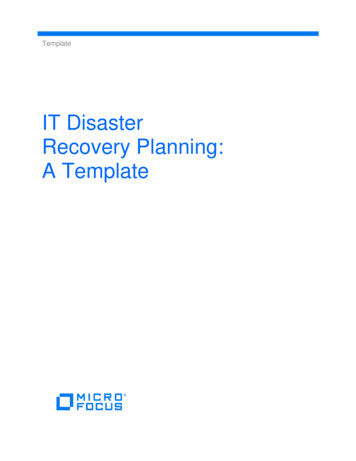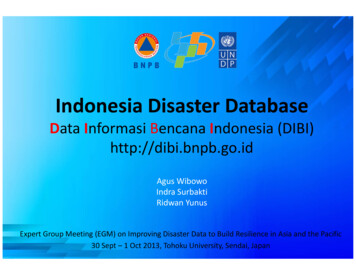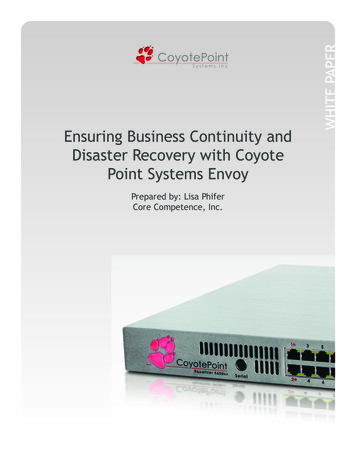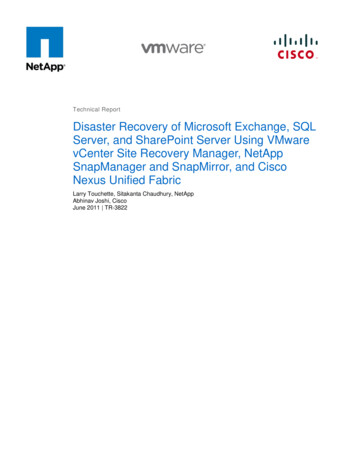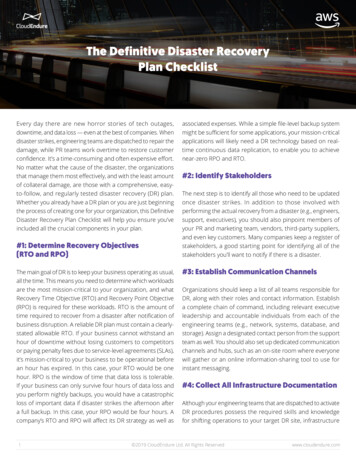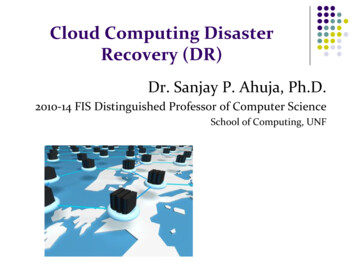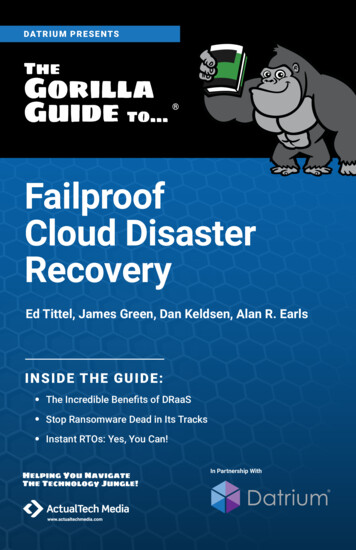
Transcription
DISASTER MGMT FINAL APPROVED copy.pdf2/3/1211:02:54 AMDisaster Management: A Disaster Manager's HandbookAbout the Asian Development BankADB’s vision is an Asia and Pacific region free of poverty. Its mission isto help its developing member countries substantially reduce poverty andimprove the quality of life of their people. Despite the region’s manysuccesses, it remains home to two thirds of the world’s poor: 1.8 billionpeople who live on less than 2 a day, with 903 million struggling on lessthan 1.25 a day. ADB is committed to reducing poverty throughinclusive economic growth, environmentally sustainable growth, andregional integration.Based in Manila, ADB is owned by 67 members, including 48 fromthe region. Its main instruments for helping its developing membercountries are policy dialogue, loans, equity investments, guarantees,grants, and technical assistance.Asian Development Bank6 ADB Avenue, Mandaluyong City1550 Metro Manila, PhilippinesTel 63 2 632 4444Fax 63 2 636 2444www.adb.orginformation@adb.orgISBN 978-971-561-006-3Publication Stock No. 041508Printed in the PhilippinesDISASTER MANAGEMENT: A Disaster Manager’s HandbookThis handbook is a ready reference guide for those actively involved withmanagement of natural disasters before, during, and after disastersituations in developing member countries. It draws upon disastermanagement practices in Asia and the Pacific and endeavors to relaterealistically to the needs of national disaster managers.
DisasterManagementA Disaster Manager’s HandbookW. Nick Carter
1991, 2008 Asian Development BankAll rights reserved. Published 2008.Printed in the Philippines.Cataloging-In-Publication DataPublication Stock No. 041508ISBN 978-971-561-006-3Cataloging-In-Publication DataCarter, W. Nick.Disaster management: a disaster manager’s handbook.Mandaluyong City, Phil.: Asian Development Bank, 2008.1. Disaster management.I. Asian Development Bank.The views expressed in this book are those of the authors and do not necessarily reflect theviews and policies of the Asian Development Bank (ADB) or its Board of Governors or thegovernments they represent.ADB does not guarantee the accuracy of the data included in this publication and acceptsno responsibility for any consequence of their use.Use of the term “country” does not imply any judgment by the authors or ADB as to thelegal or other status of any territorial entity.ADB encourages printing or copying information exclusively for personal and noncommercialuse with proper acknowledgment of ADB. Users are restricted from reselling, redistributing,or creating derivative works for commercial purposes without the express, written consentof ADB.6 ADB Avenue, Mandaluyong City1550 Metro Manila, PhilippinesTel 63 2 632 4444Fax 63 2 636 2444www.adb.orgFor orders, please contact:Department of External RelationsFax 63 2 636 2648adbpub@adb.org
ContentsList of AcronymsPrefaceForewordIntroductory NotesixxixiiixviiPART I - BASIC DISASTER MANAGEMENT ASPECTSChapter 1The Significance of DisasterThe Traditional Disaster ThreatThe New Disaster ThreatsThe Geography of DisasterThe Modern Loss FactorMajor Aspects of SignificanceChapter 2The Disaster ThreatThe General Effects of DisasterOutlines of Individual DisastersProcess of Defining the Disaster ThreatUse of Disaster Threat Information910102122Chapter 3National Disaster Management PolicyClear Definition of National PolicyThe Process of Policy DefinitionMain Elements of National PolicyArrangements for Monitoring and Review2525262931Chapter 4Major Requirements for Coping with DisasterScope of Disaster-Related ActionThe Philosophy for Coping with DisasterFoundation FactorsOrganizationPlanningUse of ResourcesSpecialist SkillsTraining Needs353536373741434546334566
IVDisaster ManagementChapter 5The Disaster Management CycleThe Disaster Management CycleComposition of Main ActivitiesApplication to Practical Disaster Management49495156Chapter 6Disaster and National DevelopmentDisaster and the National ImageThe Impact of Disaster on National DevelopmentNational Development and DisasterManagement Policy595962Chapter 7Disaster LegislationThe Need for and Value of LegislationMain Areas Covered by LegislationSample Draft of a National Disaster Act71717273Chapter 8Counter-Disaster ResourcesTypes of ResourcesEvaluation of ResourcesRoles and Responsibilities ofResource OrganizationsAnnex: Military Forces in the Counter-Disaster Role818284Chapter 9Chapter 10International Disaster AssistanceModern Concept of International DisasterAssistanceTypes of International AssistanceSources of International AssistanceArrangements by Recipient CountriesLocal Problems Arising from InternationalAssistanceThe Relationship between Donors and RecipientsLeadership in DisasterLeadership under Crisis ConditionsSome Ramifications of Political LeadershipLeadership in the Direction of Response OperationsLeadership in Resource OrganizationsCommunity LeadershipSome Leadership Attributes and 116118119120
ContentsVChapter 11OrganizationFactors Affecting Organizational SystemsOrganizational ComponentsOrganizational Structures125125129138Chapter 12PlansThe Need for Counter-Disaster PlansSome General Considerations Applicableto PlanningThe Format of PlansThe Planning ProcessCritical Areas in PlanningAspects for Consideration during PlanningAnnex: Suggested Outline for a Main Action Plan145146Chapter 13Use of ResourcesThe Need for Optimum Use of ResourcesFunctional Requirements of ResourceOrganizationsManagement of Resources for OptimumEffectivenessActivation of ResourcesGraduated ResponseCommodity ManagementAnnex: Suggested Format for StandardOperating 85PART II – LONG-TERM MEASURESChapter 14PreventionThe Need to Consider Disaster PreventionProblem Areas in PreventionPositive Approaches Toward PreventionResources Relevant to Prevention191191192193195Chapter 15MitigationGuiding Principles of MitigationExamples of Mitigation MeasuresProblem Areas in MitigationRequirements for Effective MitigationMajor Mitigation ComponentsResources Relevant to Mitigation197199200200202203207
VIDisaster ManagementFormulation and Implementation ofMitigation Programs209PART III – MAJOR FACTORS PRIOR TO DISASTER IMPACTChapter 16PreparednessThe Nature of PreparednessSome Problem Areas in PreparednessSummary of Preparedness NeedsMaintenance of Preparedness LevelsFundingWarning AspectsPrecautionary Measures Prior to Disaster ImpactResources Relevant to 7PART IV – RESPONSE TO DISASTER IMPACTChapter 17Chapter 18ResponseImportant Characteristics of ResponseSome Problem Areas in ResponseRequirements for Effective ResponseFollow-on from Response OperationsHuman Factors in ResponseResources Relevant to VariousAspects of ResponseAnnex: Notes on EvacuationLogisticsGeneral Description of LogisticsThe Importance and Place of Logisticsin Disaster ManagementResponse AspectsRecovery AspectsPreparedness RequirementsManagement, Administrative, and 9259260260264265269
ContentsVIIPART V – MAJOR POST-IMPACT FACTORSChapter 19Chapter 20RecoveryKey Points from Disaster AnalysisTransfer of Responsibilities from Responseto RecoveryContinuation of Response ActivityThe Basis for Recovery ActionProblem Areas in RecoveryMajor Requirements for Effective RecoveryHuman Factors in RecoveryResources Relevant to Recovery ProgramsProjection of the Recovery Process275276Post-Disaster ReviewThe Importance of Post-Disaster ReviewReasons for Omission of Post-Disaster ReviewAspects Covered in Post-Disaster ReviewMajor Investigations into DisastersUse of ART VI – DISASTER MANAGEMENT SUPPORT REQUIREMENTSChapter 21TrainingIndividual Country RequirementsThe Need for TrainingTraining PolicyTypes of Training and Trainee CategoriesImplementation of TrainingPublic EducationAnnex: Examples of In-Country Training Programs297298298299299301304305Chapter 22Public AwarenessThe Importance of Public AwarenessResponsibility for Public Awareness ProgramsMain Aspects of ProgramsInformation FormatInformation ChannelsOrganization of ProgramsEffectiveness of InformationMaintenance of Awareness Levels307308309310311312312313313
VIIIDisaster ManagementChapter 23ResearchThe Extent of Modern Disaster-Related ResearchThe Importance of ResearchPractical Use of Research Information315315317318APPENDIXESAppendix AAppendix BAppendix CAppendix DVulnerability AnalysisWarning and Warning SystemsSurvey and AssessmentExamples of Disaster LegislationCook IslandsPapua New GuineaQueensland, Australia323333343355355365375
LIST OF ACRONYMSADPCAsian Disaster Preparedness CenterAIDABAustralian International Development Assistance BureauAODROAustralian Overseas Disaster Response OrganizationASEANAssociation of Southeast Asian NationsCCGCentral Control GroupDMCdeveloping member countryEOCemergency operations centerGISGeographic Information SystemNATONorth Atlantic Treaty OrganisationNDCNational Disaster CouncilNDMONational Disaster Management OfficeNEOCNational Emergency Operations CenterNGOnongovernment organizationOGCOperations Control GroupPIDPPacific Islands Development ProgramUKUnited KingdomUNDROUnited Nations Disaster Relief OfficeUNHCRUnited Nations High Commission for RefugeesUSUnited StatesUSAIDUnited States Agency for International Development
PrefaceThis book stems from a regional technical assistance project that wasapproved by the Asian Development Bank in January 1990 under the title“Regional Study of Disaster Mitigation.” The objectives of the study were(i) to enhance the awareness of the ADB’s developing member countries(DMCs) of the need for an active developmental effort to mitigate the impactof natural disasters; (ii) to produce authoritative documentation on disastermanagement practices in selected DMCs; (iii) to improve the understandingof the techniques of disaster mitigation through structural and nonstructuralmitigation practices; and (iv) to provide a forum for an exchange ofexperiences in and views on designing and implementing national strategiesfor mitigating the impact of natural disasters on economic development, andthe formulation of national and regional strategies.Financed by a technical assistance grant, the study included a regionalseminar held in October 1990 for representatives of DMCs concerned anddealing with the formulation of country-specific disaster managementresponses. This seminar led to two publications. The first was a volumeentitled Disaster Mitigation in Asia and the Pacific which was published in July1991, drawing on the lessons of experience and current disaster managementpractices in Bangladesh, Nepal, Philippines, and countries in the SouthPacific, with a view to designing a general response mechanism for addressingidentified gaps in existing disaster mitigation practices in the region.The present volume is the second product of the exercise. It is intendedto serve as a ready reference guide for those actively involved in DMCs withmanagement of natural disasters before, during, and after the disastersituations. It is a further example of the ADB’s commitment to support effortsin disaster mitigation in the region. To date, no handbook has been publishedspecifically for the guidance of agencies and officials of disaster-pronedeveloping countries. This handbook is intended to fill that gap, and assuch, complements the first volume.
XIIDisaster ManagementThis handbook reflects the ADB’s ongoing concern for sustainingdevelopment process in the face of the periodic disasters that occur in Asiaand the Pacific region. It is hoped that this volume will serve as a practicalguide for disaster managers and enable them to assume an effective role tobenefit millions of people who, without efficient disaster management, wouldbe left defenseless against the vagaries of nature.A.I. AMINUL ISLAMChiefDevelopment Policy OfficeAsian Development BankFebruary 1992
ForewordMost of the world’s natural disasters occur in Asia and the Pacific. Theycause enormous destruction and human suffering in the Asian DevelopmentBank’s (ADB) developing member countries (DMCs).Environmental degradation, which is often a result of economicdevelopment and associated human settlement patterns that ignore appropriateresource management, can increase a country’s vulnerability to natural hazardsand exacerbate the impacts.As a development institution, ADB is quite concerned about the risingincidence and impact of natural disasters in Asia and the Pacific region. Lossesfrom natural disasters reduce the pace of sustained economic developmentand often lead to a heavy drain on available resources, diverting them frompursuing developmental aims. Preparing for disaster situations and, if possible,preventing them is considered by many as an integral part of developmentplanning focusing on achieving sustainable growth, poverty reduction, andenvironmental balance. ADB shares this view.In addition to utilizing its normal project lending operations forincorporating disaster-mitigation measures into developmental activitiesand financing disaster-rehabilitation projects, ADB may rely on its technicalassistance facility for promoting disaster mitigation. Such assistance isavailable to its DMCs for the formulation of disaster-mitigation plans, devisingmitigation strategies, and designing measures to carry them out. This type ofADB assistance is available on either a regional, country, or project level.An example of technical assistance on the regional level is the presenteffort by ADB to assist its DMCs to gain a better understanding of disasterrisks and vulnerability to natural hazards, and to focus their attention on disastermanagement issues. This Handbook, as well as the first volume DisasterMitigation in Asia and the Pacific published in July 1991, are products of theADB-financed Regional S
Disaster management: a disaster manager’s handbook. Mandaluyong City, Phil.: Asian Development Bank, 2008. 1. Disaster management. I. Asian Development Bank. The views expressed in this book are those of the authors and do not necessarily reflect the views and policies of the Asian Development Bank (ADB) or its Board of Governors or the
